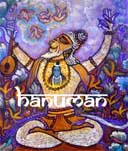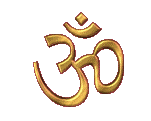
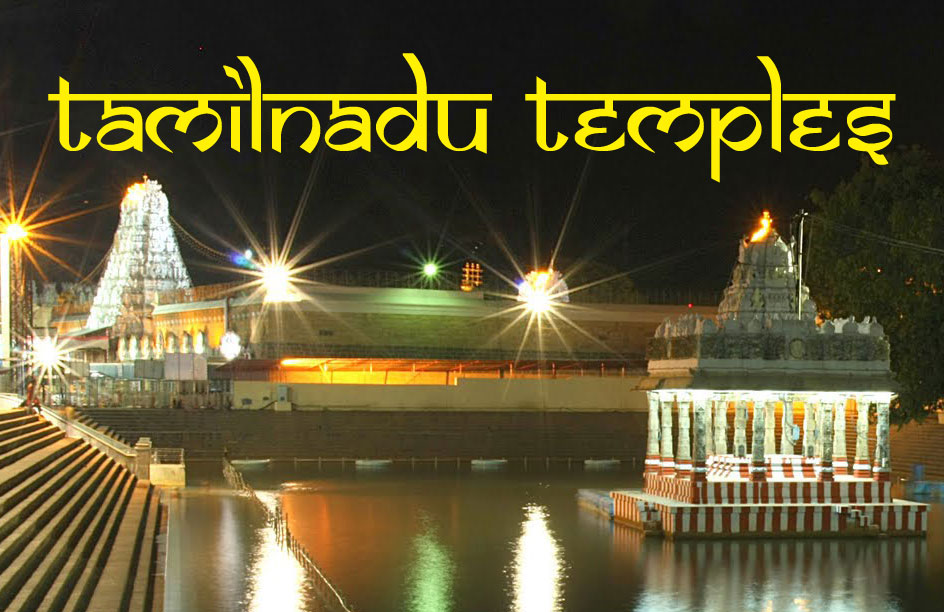
Thirupathi
The land lying between Thirupathi in the north and Kannyakumari in the south is indeed a blessed land. The number of temples dotted all over this ground is incredible. All of them are ancient and filled with the ecstatic fervour of those who built them as well as the great kings of Pandya and Chola who conceived them and were prepared to pay anything in order to get the perfection which they dreamt about. Their only desire was to glorify God in His many manifestations and thus they made these enormous, elaborate and exquisite works of art and sculpture. Hard granite stones seem to move and talk to us as if they have come alive. If stones could talk they would be able to tell us such tales of devotion that we would be struck with wonder and fall down and worship the Lord whose tales they were trying to describe. This is the land of the great Lord- Maheswara and His consort, Parvati and His children Ganesha and Karthikeya. It is also the land of the nine planets since Shiva himself is the controller of the planets and if we propitiate Him, they will also befriend us. This is a land of mystery and magic where our ancient culture is still throbbing with life for we see that even today these temples are centres of great spiritual activity and inspire great devotion. Thousands of people still throng to these temples which are living forces of energy even after five thousand years. They are not like many of the north Indian temples which have grand architecture but which have been neglected and are relics without any life for no rites or pujas are conducted.
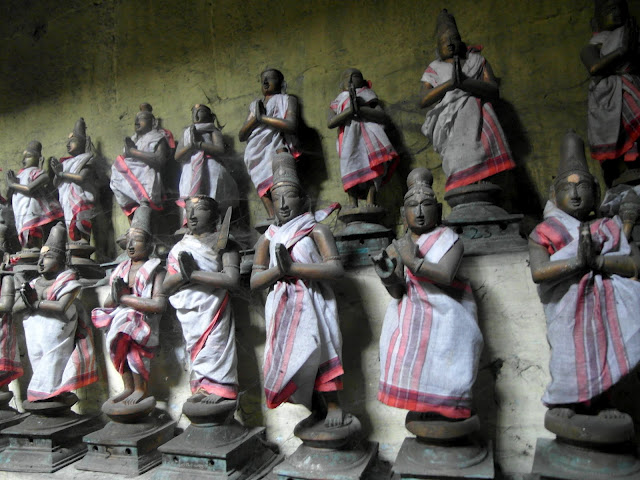
Nayanmars at Thirukkazhukundram
The reason for this easy to find. What makes a temple great is the number of saints who have visited it and cast their glow of spirituality on them. Tamilnadu is a place which has had the greatest number of Shaivite saints known as Nayanmars and Vaishnavite saints known as Alwars. The country has been made holy due to the dust of their feet. Their lives are impossible to describe. They lived only for the sake of their Lord – be it Shiva or Vishnu. He it was, that guided and controlled their every thought and action so that everything they did was for Him alone. Some called them crazy but their lunacy was of a special kind. They were crazy about God. They had but one desire and that was to attain union with Him. The story of their lives is one of extreme sacrifice and incredible acts of devotion. Again and again the Lord of their hearts would test them, sometimes with tests which might seem beyond human endurance to us but they passed with ease for they did it for the sake of their Beloved. To these great saints who loved Him with all their hearts and soul, the Lord in turn gave His greatest blessings. He was their friend, guide, guru, master and beloved. He took many roles in order to test and bless them. Amongst the Nayanmars or Shiva bhaktas four stand out as being the greatest. They are known as the “Great Four” and their names will go down in history as being the greatest lovers of God. They are Sundaramurti Nayanar who lived in the 8th century, who was called the Friend of Shiva, SaintAppar who was known as the Servant of Shiva, and who was the forerunner to Tiru Jnana Sambandar who was known as the Son of Shiva. He wrote the famous collection of songs known as Thevaram which is still sung in all Shiva temples, and lastly, Manikkavachagar who was called the Knower of Shiva. All four have written many songs to the Great God which would melt the stony heart of even a hardened atheist. In these songs they have extolled the greatness of their Lord-Shiva. These ballads are filled with stories of Lord Shiva’s grace and proclaim the greatness of the lingams and idols of Shiva and of the temple tanks and holy trees and so on. The poetess Avvai has sung that “Love is Shivam!” Thus Shiva is the epitome of compassion and love. He despised none. The lame and the crooked, the ghouls, ghosts and spirits formed His retinue.
The Chola and Pandyan kings filled this land with countless shrines. Their palaces and fortresses have disappeared in the course of time but these great edifices to the glory of God have endured for eternity. These temples contain some of the outstanding examples of art in the world. The wealth of the Chola kings was spent in portraying the glory of the Great God, Mahadeva. They took the “Atti” flower, the favourite of Lord Shiva as their own emblem.
It was only through the grace of the Great Lord Himself, that I got the opportunity to visit this Deva Bhumi for five glorious days in the month of Magha or Thai just after Makara Sankranti. During this short period of time I was taken to many of the exalted temples of this land. So many experiences were encapsuled into these five days that I feel as if I have been dipped in the ocean of bhakti which is found in this holy land of Tamilnadu.
Mathurantakam
Rama temple
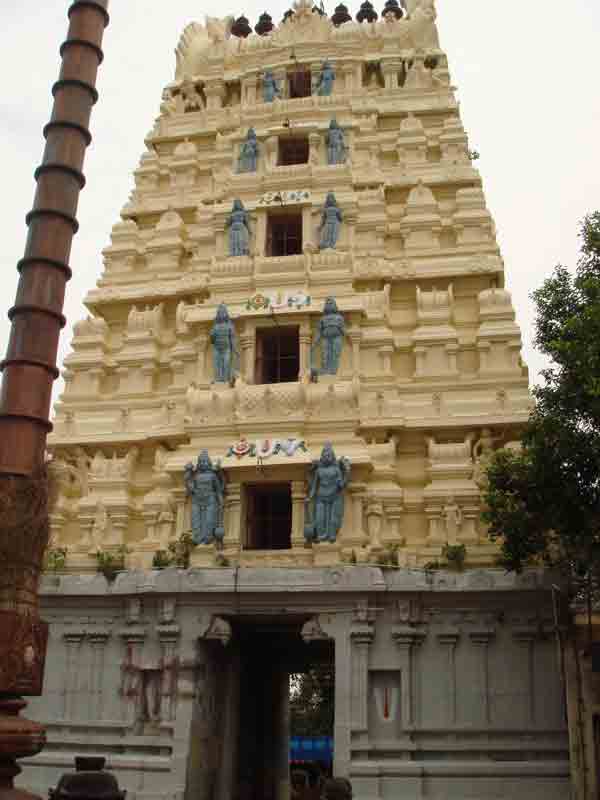
The first temple we visited after leaving Chennai was the Sri Rama temple at Mathurantakam. Unfortunately it was 12o’clock when we reached there and the priest was just about to come out after closing the temple. I was terribly disappointed and felt that this was a bad omen for the rest of our tour. I begged the priest to open it once again and give us a glimpse of the deity. In response to this he gave us a lecture on how terrible it was to ask him to open a temple which had just been closed and how important it was to him to return home and cook his lunch etc. There were quite a few others waiting behind us and they also added their pleas to ours. The priest went on scolding and talking but the Lord was not going to let him get off like this. At the end of the tirade he suddenly threw open the doors and I gasped at the huge figure of Sri Rama and Sita. This idol was especially sweet since it is the only one in India where Rama’s right hand is seen holding Sita’s left in a tight grasp. We were of course very happy. I realized it was another of Vanamali’s tricks to see how we took misfortunes.
Rama here is also known as Erikatra Rama or the one who protected the lake. The story goes that during one monsoon, the village lake was threatening to overflow and flood the whole village. The villagers went to the English Resident and told him to do something about it and he promised to look into the matter the next day. But it kept raining the whole night so he decided to go and survey the lake in the night. When he went there he was amazed to see two young and handsome boys carrying bows and arrows patrolling the lake side. He realised that they must be Rama and Lakshmana and that he was indeed fortunate in having had their darshan.
This temple is famous for being the place where the great saint Periya Nambi initiated Sri Ramanujacharya – the exponent of Visishtadvaita. He was also given the insignia of Vishnu – the Conch and Chakra under the Vakula tree under which we happened to be standing. One of the young priests made us sit down and gave a talk on the entire proceedings by which Ramanucharya had been initiated by his guru but unfortunately I cannot remember everything.
Panchamukha Hanuman
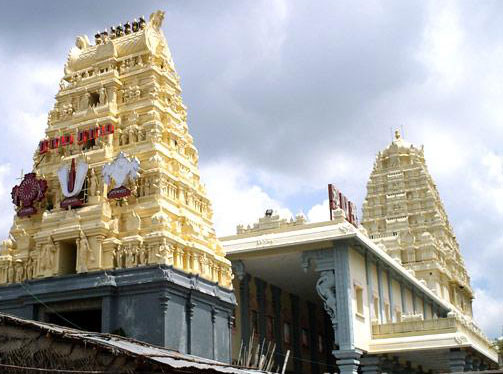
Since it was a Tuesday I had a small desire to be go to some Hanuman temple. Interestingly when I asked the driver he unhesitatingly replied that we could make a small deviation and go to the Panchamukha Hanuman in a place called Panchavati. I would have been satisfied with even the smallest of idols in a way side shrine, but there it was a colossal thirty-six foot figure towering above me. Here one can also worship Sri Rama’s padukas (footwear).
Melmarivathur
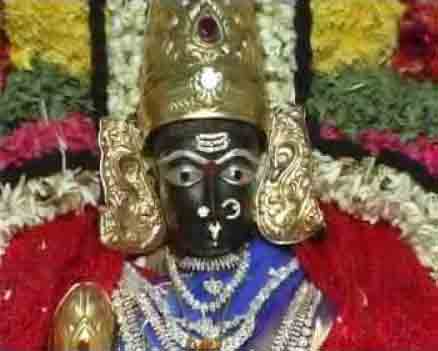
Adi Para Shakti Melmarivathur
Next the driver urged us not to miss this opportunity to visit the siddha- peeth for Shakti known as Melmarivathur which he said was on the way to Chidambaram and was open all through the day. When we reached the place we could not find a single parking place even on the main highroad. The whole road was packed with buses carrying hundreds of pilgrims who had come there on that auspicious day of Pongol. The pilgrims were mainly women all dressed in yellow or red. Apparently a movement has been started in Shakti worship similar to the worship of Ayyappa in Kerala. All these pilgrims go from temple to temple before they eventually land up at Melmarivathur. Adi Parashakti is supposed to have manifested herself in the form of a pinda or rounded lingam at this place. Many siddhas or perfected souls had worshipped her here in that form. The present pujari was also a siddha and was known as Bengaru Addikal. He is supposed to be endowed with many miraculous powers and does a lot of social service to the community.
We were doubtful if we would be able to go anywhere near the deity. The queue was snaking its way from the road onwards. We did not stand in the queue but again due to Her grace we just went in and found ourselves just in front of Her. Of course we were standing behind the barriers at a little distance but we had a wonderful vision of Her and felt blessed to be graced with Her benign looks.
Chidambaram
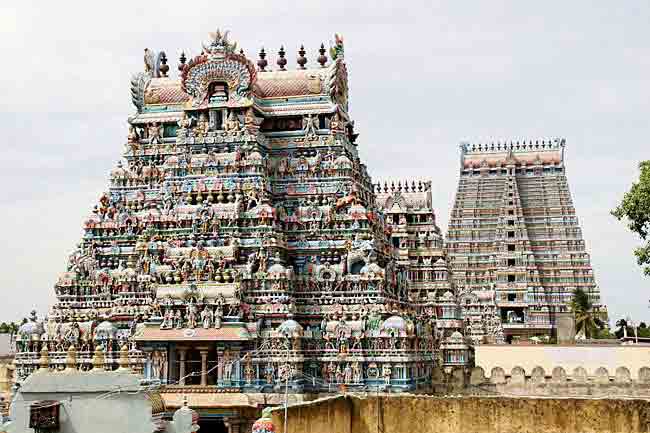
Chidambaram
Our night stop was at Chidambaram and we reached there at about 4 pm in time for the opening. Chidambaram is famous for the exquisite idol of Nataraja which adorns so many homes not just in India but all over the world for none who have seen this figure can help but be attracted to it and wish to possess it! Shiva has manifested Himself as the Pancha Maha Bhutas or the five great elements in five places. The five mahabhutas are akasa or space, Vayu or air, agni or fire, apas or water and prithvi or earth. Of these Chidambaram denotes akasa or space. Akasa is all pervasive and is the background on which the drama of life is enacted. The Shivathandava or the dance of Shiva which is depicted in the figure of the Nataraja, is a pictorial allegory for that all pervasive space or stage on which He dances the ballet of cosmic life. Chid plus ambaram – Chid means consciousness and ambaram is vast, immeasurable space. Thillai is another name for the Nataraja. He dances to the cosmic sound of Aum. The five-syllabled mantra of Shiva, Na-ma-shi-va-ya, stands for His five functions-creation, preservation, destruction, illusion and salvation. Thus His dance includes the functions of Brahma, Vishnu, Rudra, Maheswara and Sadashiva. He activates these five functions through His Tandava (dance). Shiva has been dancing through eternity the Ananda Tandava or dance of bliss for the sake of His devotees. The sound of the drum is what creates the universe, the hand bestows grace and gives benediction, the fire denotes destruction, and the foot trampling the dwarf destroys ignorance and grants liberation. Shiva is the Lord of dissolution but what He destroys is not the worlds but the illusion that conceals the truth that this world really exists. He burns our bodies made of ignorance and stupidity in the burning ghats which He inhabits.
We reached this holy spot in the evening and took a bath and went immediately to the temple. We entered through the eastern gate and were met by one of the Dikshitars or pujaris who took us straight towards the Ponnambalam. We climbed up the steps of this hall and came to the Chitrambalam. This is Chid-ambalam or Chid-ambaram, the hall of the space of consciousness. This is the holy of holies where the Lord dances through eternity in order to keep the five functions of the universe going. All these will come to a stop if Nataraja stops dancing. The five silver steps leading to the Chitrambalam stand for the five syllables of the Panchakshari mantra (Na-ma-shi-va-ya).
I had actually expected a much bigger figure but was delighted to see this entrancing form of the divine dancer in a much smaller form than I had imagined. Thanks to our guide we were able to stand right in front and adore Him with our eyes and our hearts as long as we wanted to. He is clad in tiger skin and wields the drum, fire, mriga or deer and shula or trident and is decked with a garland of serpents. His left leg is raised while the right tramples the dwarf of ignorance known as Muyalaka. I was fascinated by the anklets He was wearing on the raised leg. This is one of the few Shiva temples which has an anthropomorphic figure instead of the usual lingam.
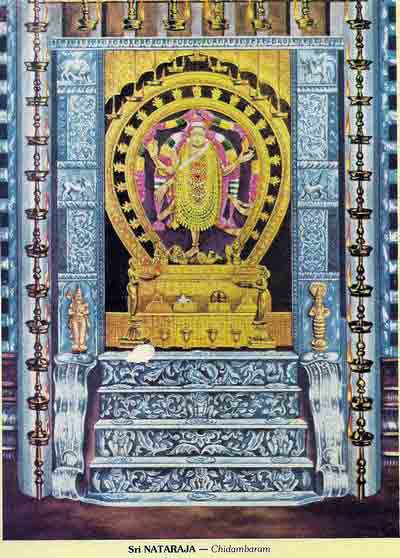
We had been asking our mentor to show us the Chidamabara Rahasyam or the mystic secret of the temple. The secret is that God exists in the form of formless space. How can one worship the formless? Here a method has been devised. Just next to the Nataraja there is a small latticed window. We were told to position ourselves at this window and watch the opposite wall carefully. The wall was covered with a curtain and we were told to watch this curtain. We watched with anxious anticipation wondering what was going to happen. At the appropriate time the curtain was removed for a few seconds and arati (waving of lights) was shown to the wall on which were hung fifty one golden vilva leaves. The curtain is dark on its exterior side (indicating ignorance) and bright red on the interior side (indicating wisdom and bliss). The Chidambara Rahasya is represented by these strands of gold Vilva leaves which hang behind the curtain. To the right is the idol of His Consort- Goddess Sivakamasundari. The Lord is said to continuously dance in a state of eternal bliss "Aananda thaandava", with his consort Sakthi or energy called Shivakami. During this ritual, the Chief priest, of the day who has to be in a state of Shivohambhava (Shiva - the Lord, in His Sandhi form - Shivo-, aham– me / us, bhava - state of mind), parts the curtain, indicating the withdrawal of ignorance and reveals the space, and the Lord’s presence.
The Chidambara Rahasya, is hence representative of the time when we totally surrender ourselves and allow God to intervene and remove our ignorance, even as we get to 'see and experience' His presence and hence - bliss.
All this took less than five minutes and the curtain was drawn and everything was as it was before. Not everybody has a chance to see this so we were thrilled.
The story of the Nataraja nrittyam (dance) was told to us later. The great sages Patanjali, Vyagrapada and Upamanyu were very anxious to watch this great dance of creation of Sadashiva. One Thursday in the month of Tamil month Thai when the star pushya coincided with purnima (full moon), the sages finished their ablutions and rituals and came at the Jnana Sabha (the hall of wisdom). They saw the gods headed by Indra who had already assembled there. A great fanfare of the celestial musicians preceded the arrival of the divine pair, Brahma and Vishnu. The three thousand sages known as Trisaras followed. Nandiswara, the deputy of Lord Shiva now appeared in a dazzling light and seated everybody. As the time came to fifteen naligas, the curtain of ignorance opened to give the divine sight of Nataraja, the cosmic dancer who entered with His consort, Parashakti, the power of energy in the cosmos.
For a brief moment He paused as if to allow them to take in His amazing form. He wore the tiger skin with a serpent as His sacred thread, golden kundalams (earrings) dangled from His ears, the blue sapphire hung on His throat like the poison He had drunk to save the world. The Ganga and the crescent moon adorned His head, His eyes were overflowing with compassion for the world and the third eye which had burnt Manmatha, the Lord of desire was closed. His right hand was playing on the damaru or small drum, the other was holding the flame of destruction, the other right hand was bestowing grace and the other left pointing to His raised foot. The right foot was trampling the dwarf of ignorance. Thus bedecked the supreme Lord of the universe, Mahadeva, Maheswara appeared before the bemused eyes of the spectators. Then the music began to the accompaniment of His dance. The Vedas tinkled to the tune of His anklets as He danced the dance of universal creation and destruction. His locks were flying in all directions as the Lord danced the Ananda Tandava- or the Dance which gives universal joy!
All those who were watching were transfixed with joy and some also danced in ecstasy. At the end of this remarkable performance the Lord addressed Patanjali and Vyagrapada and asked them to choose a boon.
They bowed and with the usual compassion to all as shown by the great sages, they asked Him to continue to perform the Ananda Tandava at that place eternally in order to enable all humanity to attain liberation. Nataraja acceded to their request and hence it is that He has been dancing here for all eternity bestowing His grace on all those who go there.
The pujas here are done only by the Thillai Brahmin Dikshitars. They were not expected to take any remuneration for their services. In olden days, during their tenure of office, the dikshitar used to place a copper sheet at the feet of Shiva in His form as Kala Bairava every day while closing the shrine and when they opened the doors in the morning, the copper sheet would have changed to gold. With the proceeds of this gold they would manage their family so they had no desire for any extra income. It is not known when the alchemy of changing copper to gold ceased. But it is a fact that these dikshitars do not have the greed for money which is displayed in many of the other great temples. The rituals for the temple are from the Vedas and set by Patanjali, who is said to have inducted the Dikshitars into the worship of Shiva as Nataraja. Every married male member of the Dikshitar family gets a turn to perform the rituals at the temple and can serve as the chief priest for the day. Married Dikshitars are also entitled a share of the temple's revenue.
The temple owns no land. The dikshitars perform the six daily pujas, special rituals and festivals from the income of private owners who consider themselves blessed to have the honour of meeting the temple expenses from their own income.
At last I tore my gaze away from Him and went with the dikshitar for a guided tour of the temple. The temple has five sabhas or assembly halls, known as Chitrambalam, Ponnambalam, Perambalam, Nritya Sabha and Raja Sabha. As mentioned before the Chitrambalam is the sanctum sanctorum which we had just worshipped. It is placed in the Ponnambalam where the Lord takes His ablutions. The Chitsabha houses a small sphatika(crystal) linga (Chandramoulisvara), believed to be a piece that fell from the crescent moon adorning Shiva's head and installed by Adi Shankara. The lingam is associated with the intangible fifth element, akasha (ether or space the eternal infinite expanse where the dance of Shiva takes place). Daily six pujas and abhishekams are done to this crystal lingam. The puja is also done to a small gem-carved figure of Ratnasabhapati. We were deeply fortunate to witness these abhishekams.
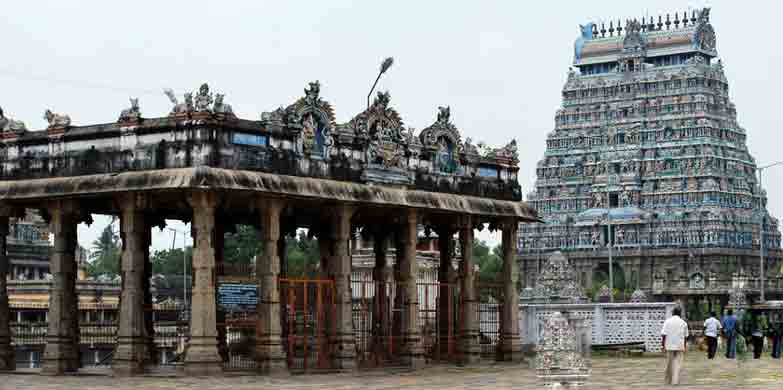
When you come out of this sabha and go round it you are able to admire the beauty of the Ponnambalam which is covered with pure gold. The Ponnambalam has nine golden pots or Kalashas on top. These represent the eight siddhis and the mind. The hall is built on sixty four wooden rafters representing the sixty four arts or kalas. The hall is designed in the form of a human being. Just as the human heart is not in the centre of the body but a little to the left so also the sanctum is a little to the left and not in the middle because human blood circulates only through the sides and not straight up. The entrance paths to the shrine are only at the sides and not straight in front. In the Kanaka sabha or Ponnambalam in front of the idol, the eighteen pillars indicate the eighteen Puranas, the five silver steps represent the Panchakshari mantra (namashivaya), and the ninety six silver interstices denote the ninety six cults. The five pillars of the Chid Sabha indicate the five senses. Of the ten pillars in the Brahma Pida, the lower six stand for the six sastras and the upper four for the four Vedas.
The temple premises have fifty one acres. Four huge towers guard the entrances from all four quarters. They rise up to forty metres and have seven stories and thirteen copper domes. A colossal granite wall encloses all the gopurams (towers). The four great nayanmars are supposed to have entered the temple, one from each tower – Sundarar through the north, Sambanda through the south, Appar by the west and Manickavachaka by the east. In fact he is supposed to have vanished into the sanctum after having composed his poem.
When you go out through the south entrance from the Poonambalam you get to the flagstaff and there is the hall known as the Nritya Shabha where Shiva performed the Urdwa Tandava in which He raises His left leg in a straight line up to His head close to His ears. This hall is shaped like a chariot with wheels and horses.
There are also four shrines to the four great Nayanmars, Sundarmurti, Appar, Gnanasambandar, and Manickavachagar.
The Raja Sabha is the thousand pillared hall in which the Chola kings were crowned.
The temple is also famed for its sacred pools which are many and are called Shivaganga, Paramananda Kupam, Vyagrapada tirtha, Anantha tirtha, Shivapriya, Pulimedu, Kuyya Thirta and Thirupakadal. Unfortunately we were able to see only two of these tanks. Near the Shivaganga tank there is a solid iron pillar. If we clutch the pillar and look we get a clear view of three of the gopurams of the temple. Even if you move a foot away to any side the view is blocked.
The name of the Shakti here is Shivakami Sundari. One has to come right out to the outer courtyard in order to get to her shrine. She has a beautiful pose and her eyes radiate love. It was apparently built by one of the later Cholas who also constructed the tank in front.
Next to this temple is a beautiful shrine to Karthikeya. The temple was built by a Pandya king and is in the shape of a chariot with wheels and elephants. As usual it has a wealth of intricate sculptures. I found the idol of Kartikeya to be most striking.
One of the largest idols in Chidambaram is the gigantic form of Ganesha known as Mukkuruni Vinayaga. It is eight feet high and capable of blessing devotees with all their heart’s desire.
This completed our tour of the temple and its premises. But it is a fact that we would not have been able to take in everything even if we stayed there for a full month.
The next morning we returned very early to watch the first puja. The day begins with the chief priest of the day, who has to perform a number of rituals to purify himself and then assumes the Shivoham bhava (I am Shiva), after which he enters the temple to do the daily rituals. The first ritual is to waken the Lord. The last ritual of each day is to take the padukas (footwear ) of the Lord in a palanquin to the palliyara (bedroom). So the first ritual in the morning is to take Shiva's footwear (padukas) at 7:00am from the palliyara (bedroom) to the sanctum sanctorum in a palanquin accompanied by devotees with cymbals, bells and drums. This was a really moving spectacle and it was our great luck to have witnessed it even though we were unable to witness the ritual the previous night when the footwear was taken to the palliyara.
We stayed on till the first puja was over and then sadly we had to depart since we had a very busy program. Again and again my eyes drank in the beauty of the Divine Dancer as I slowly and reluctantly went towards the east gate by which we had come.
Swamimalai
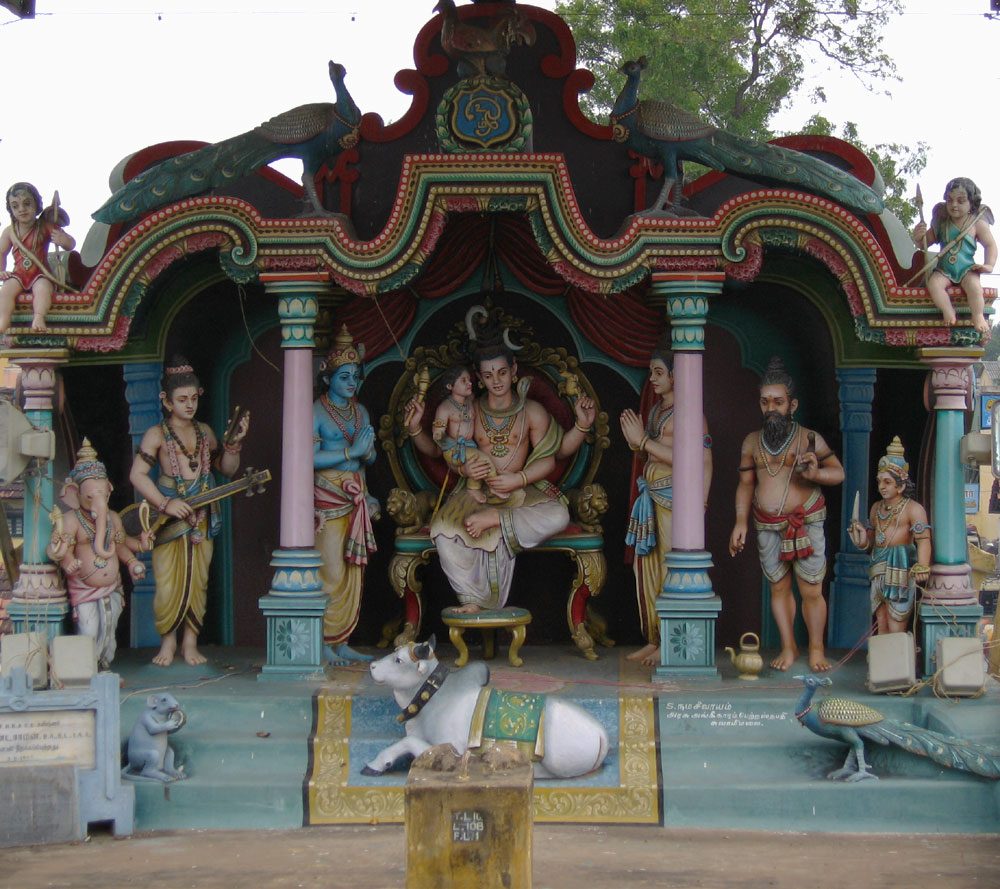
Swamimalai
The next temple which comes vividly to my mind during our tour of the Tamil Nadu temples is Swamimalai which is dedicated to Lord Muruga or Kartikeya. By His grace I had been taken to five of his ‘Arupadai Veedu” or six temples dedicated to him. The only one I had not been was Swamimalai which is said to be one of the most important since there he plays the role of teacher to his own father. When I was planning the itinerary, somehow I didn’t realise how close Swamimalai was to Kumbakonam and Tanjavoor. While searching the web for a good hotel in Tanjavoor, I kept returning to the Indico hotels and when I looked for the location I found that it was actually in Swamimalai! I couldn’t believe it. Twice before Subramania had done the same thing when I was in Madurai where a devotee had taken me to two of his arupadai veedu without my knowing it. In fact I had known it only after reaching there. Now he was repeating this trick. Even though I knew the name Swamimalai and was anxious to go there I never dreamt that it could happen on this trip. But there it was. The indications were very clear. This was the hotel we were meant to stay since it was situated very close to the temple of Muruga. My joy knew no bounds and I booked the hotel straight away even though it was a heritage hotel and quite expensive.
We reached there by about 3 pm and were pleasantly surprised to see the beautiful surroundings and the old fashioned aspect of the hotel which had been built on an old Tamil village of the previous century. We were greeted with a lighted lamp and the ringing of bells and given a foot massage – all very enjoyable. Then the manager looked at me and said “Madam I have prepared a room for you but now after seeing you and hearing that you are from an ashram I was wondering if you would like to occupy the room in which Mahaperiyaval of Kanchipuram had stayed about forty years ago.” I couldn’t believe my ears. Here was another miracle. My guru is the present Periyaval of Kanchi Kamakoti Peetham and we had just had his darshan two days ago! And now here was an opportunity being given to stay in Mahaperiyaval’s room. He was one of the most enlightened men of his age and was a contemporary of Ramana Maharishi and Aurobindo. In fact they were known as the three gems of that age and all lived within a few miles radius of each other – all in Tamil Nadu. Aurobindo in Pondicherry which we had just passed, Ramana Maharishi in Thiruvannamali which was very close and Mahaperiyaval in Kanchipuram which was again very close.
I realised that I was being twice blessed by Muruga – one to get his darshan and one to live in that holy room which had been blessed by my guru’s, guru.
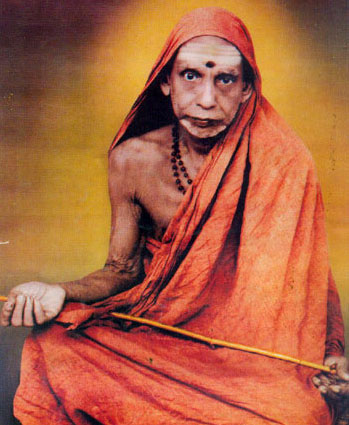
Mahaperiyaval of Kanchipuram
Needless to say we were overjoyed to go to that room which had been sanctified by Mahaperiyaval’s holy feet. The next day was Thursday – Guru’s day and it was an enthralling experience to meditate in that room. There was a picture of him outside the door and one of Adi Shankara. Of course the room had been modernised and a bathroom put in but even then it was still as small as it would have been in his time and retained an aura of his personality. In front of the room there was a small stream which was an off –shoot of the Kaveri River. Apparently the village was in dire straits with no rains for the past two monsoons and the villagers begged Mahaperiyaval to do something for them. There was a rock in the middle of the stream which was dry at that time and on this he would sit for his evening meditation. After the villagers made this request, he is said to have thrown a coconut on the dry bed below while sitting on the rock. Immediately water gushed out and soon turned into the stream which we were looking at now. This stream encircled the village and went on to bless other villages near by!
That morning after a wonderful meditation and puja we went to the temple of Swaminathan as he is called here. The temple has been constructed on an artificial hill and has sixty steps leading to it. Each step denotes a Tamil year which is written along the sides. We were told that if we sit on the step of the present year we would be able to come back. Many people were sitting on various steps so we also joined them.
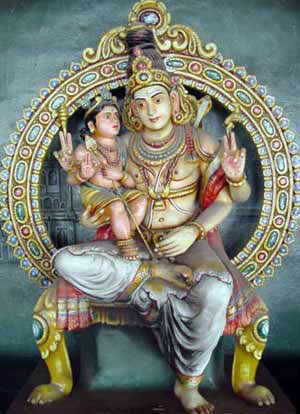
Swaminathan
I was so anxious to see Muruga that I didn’t even wait to get a ticket. Lots of people were sitting in the middle section waiting for the abhisheka ceremony which is a very important ceremony in which he is given a ritual bath. We were brought there just in time for this.
Even though we had no tickets we found ourselves right in front of the sanctum. In fact when we suggested getting tickets, the priest advised us not to do so since we would be able to see better from where we were standing. The Muruga idol here is huge - six feet in height. He was covered in gold ornaments, wore a golden crown and carried a diamond vel or lance in his right hand. As usual when so much grace is showered on me, my eyes automatically seem to fill with tears and a feeling of total unworthiness overwhelms me. I had made a list of requests to be placed before him but could think of nothing but “Muruga,Muruga, Muruga.” Somebody mentioned that the ceremony would take a long time but I was very anxious to stay and just as well for it started soon after. We saw all the different abhishekams with water, oil, honey, milk etc and then the curtain was drawn for some minutes and when it was opened, once again he was dressed in all his finery. They did the elaborate arati with different types of lamps. I was entranced all the while. At last when everything was over we were given the Prasad, milk and panchamritam. Next morning again we went for the morning darshan and left in a glow of glorious grace and joy.
Now for some mundane facts about the temple. It is situated five kms from the temple town of Kumbakonam. Of the multitude of temples dedicated to Skanda, the 6 most important ones are the Aaru Padai Veedu shrines, where it is believed that Skanda the commander of the Gods, sojourned during his battle with the demon Soorapadman. These shrines have been revered in 2000 year old Tamil poetry of the Sangam Period. These six houses of Lord Kartikeyan are – Palani, where he is supposed to have gone from Kailas after a small tiff with his parents.
Tirupparamkunram near Madurai which commemorates his marriage with Devasena, the daughter of Indra. There is also a famous shrine to Shiva here that has been eulogised by the Tevaram hymns of the Nayanmars.
Tiruchendur enshrines Subramanya and Senthilandavar in a vast temple with a lofty gopuram visible for miles, on the shores of the ocean in Southern Tamilnadu.
Palamudicholai near Madurai is a gem of a temple set in the hills surrounded by forests. There is a small waterfall known as Akash Ganga the waters of which are said to have miraculous powers.
Tiruttani near Tirupati and Chennai enshrines Subramanya in a hill temple. One has to climb a flight of 365 steps to reach the shrine. It represents the site of Skanda's marriage with Valli though there is another theory that his marriage with Valli took place in a famous place of pilgrimage in Sri Lanka known as Katargama. Here the tribes living near the temple are known as the Veddas which was the name of Valli’s tribe. By His grace I had gone to this temple also during the peak of the Tamil riots.
Finally we come to Swamimalai. The legend goes that he taught the meaning of the pranava mantra (aum) to his father Shiva here and hence he is known as Swaminathan. The history of the temple as given in the "Sthala Puranam" is as follows: Once, Lord Brahma, the creator had slighted Muruga when he visited Mount Kailash where Lord Shiva resides. Hence Muruga became angry and asked Brahma to explain to him the method of creation. Brahma said that he created with the help of the Vedas. Muruga then asked Brahma to recite some hymns from the Vedas. Brahma started to recite the hymns starting with the pranava mantra - Aum. Muruga stopped Brahma and asked him to elaborate on the meaning of the holy word “Aum”. Lord Brahma couldn't give him a satisfactory answer and Muruga had him imprisoned. With Brahma in prison, all creation came to a standstill and the devas prayed to Lord Shiva to get Brahma released.
The Lord came to his son and asked him to release Brahma. Muruga refused to release him since he felt that Brahma was not the right person to do the work of creation as he did not even know the meaning of the pranava mantra. In order to test him, Shiva asked Muruga to tell him the meaning. Muruga told Shiva that he was ready to instruct him but placed the condition that, even though he was his father he should give him the respect owed to a guru. Shiva agreed and Muruga gave him a elaborate discourse on the meaning of the pranava mantra. Shiva listened to this with due respect as if he was only a student.
This important and interesting incident happened in Swamimalai and hence Lord Muruga is known as "Swaminatha Swami" meaning "The Teacher of Lord Shiva".
Vaitheeswaran temple
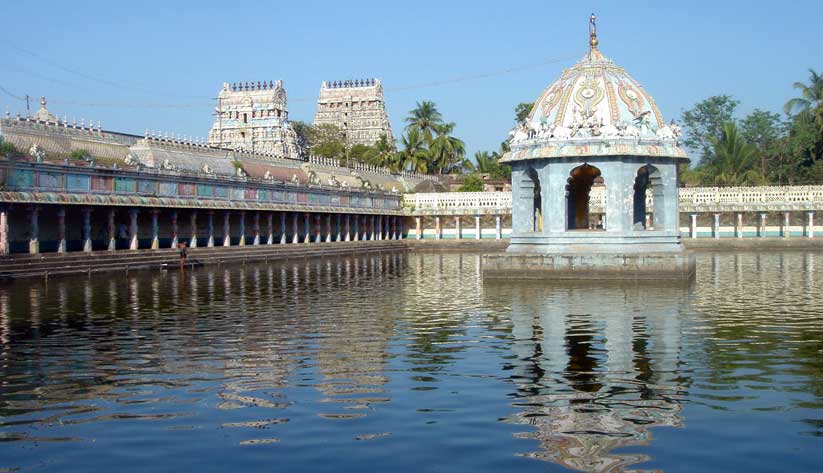
Vaitheeswaran temple
This part of Tamil Nadu is famous for the temples to all the nine planets. Each of these is found in huge Shiva temples which became famous due to the power of the graha or planet it houses.
After leaving Chidambaram the second temple we went to was the Vaitheeswaran temple which is only 27 kms from Chidambaram. It is known for housing the powerful planet Angaaraka or Mars. Those who are passing through the bad phase of being under this planet in their horoscope always find their way to this temple and offer worship both to Shiva and Angaaraka. The word Vaitheeswaran means the God of Healing. All types of diseases either caused by Mars or otherwise are cured here. A dip in the tank known as Siddhamritham which is supposed to contain nectar, is supposed to cure all diseases. The goddess is known as Thaiyalnayaki and she holds a pot of medicinal oil in her hand. Her name means the goddess of stitches. She is the goddess for those who have undergone surgery and those who are going in for surgery.
Three things are offered at this temple – salt, pepper and jaggery. The jaggery is to be put into the tank and the other two are offered to Shiva.
Of the many idols which are found in this temple the most important is the one to Angaaraka or Mars to which many pujas and offerings are made. The bronze idol is taken out every Tuesday on a goat. Angaaraka is described as having a fiery complexion and is the overlord of the signs of Scorpio and Aries.
The village is also known for the incredible palm leaf astrology (naadi shastram) in which the lives of all the people who go there have been written on palm leaves by one of the great sages, like Agastya Muni, Shiva Muni or Bharadwaja. These were written thousands of years ago so it’s really miraculous how these sages knew all about the lives of those people who would go to these astrologers in the future. It just shows that Time as Hinduism asserts is an un-ending river, the banks of which can be seen both forwards and backwards by the great seers. They could see into the future as easily as they could see into the past. We also went and had our leaves read and the revelations were quite astonishing. I was very pleased when he told me that this would be my last birth!
The legend about this temple goes back to the Ramayana. Rama, Lakshmana and the Saptarishis are supposed to have worshipped the deity in this place. Rama and his brother Lakshmana cremated the vulture king Jatayu who was killed by Ravana when he tried to prevent the abduction of Sita at this very place. There is a pond at this temple called Jatayukundam (Jatayu’s pond).
One of the nine planets, Angaaraka (Mars), suffered from leprosy and was cured by Vaitheeswaran and from then on, Angaaraka took up his residence in this temple.
Parvati, the consort of Shiva, asked her son, Subramanya to appear before her with one face instead of six. When he did so, she was pleased and presented him with the vel (spear) to slay the demons. Subramanya overcame the asura Surapadman but in the war, many of his soldiers were severely injured. All of them were healed by the Lord as Vaitheeswaran.
THIRUNALLUR. Temple to Saturn.
The Nadi Shastram had asked me to go the temple of Shani or Saturn which is housed at the Shiva temple at Thirunallur and do an archana to get rid of my evil karmas. Strangely enough this temple was quite close to where we were staying so we went there in the evening. Just as we reached the premises, the abhishekam or ceremonial bath with milk was given to Him so we were able to watch that. After that He was clothed in black silk and finally the arati was done. We had indeed gone at a most auspicious time so I was really grateful and hoped that my sanchita karmas had been wiped out.
Uppaliappan
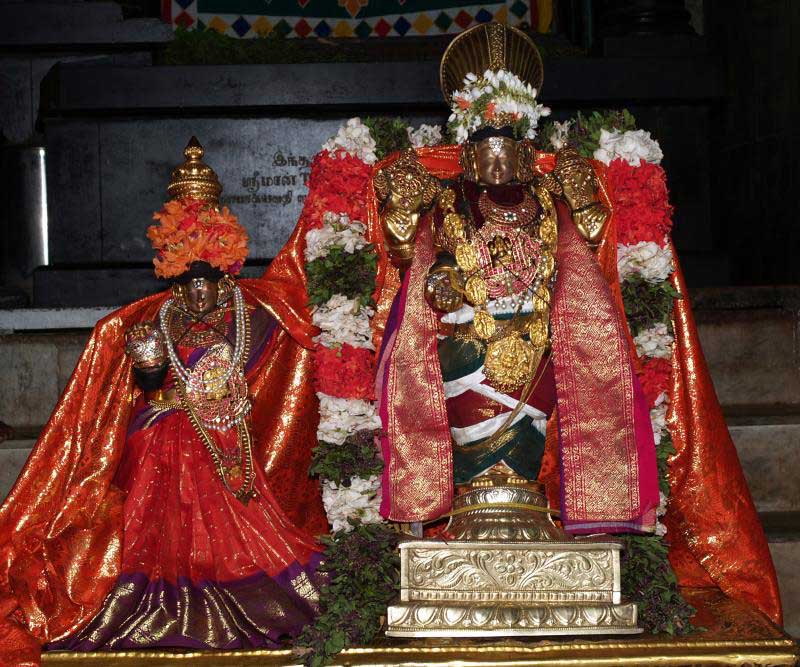
Uppaliappan
The next on our list was the famous temple to Uppaliappan who is supposed to be the elder brother of Thirupati Balaji. The idol is huge -30 feet tall. Markandeya Rishi sits on the ground on the Lord’s left and his daughter Bhuma Devi sits on the right with her left leg tucked beneath her thighs like a child. Uppaliappan means “without salt”. It can also mean “beyond comparison”. The story goes that the Lord once went to the Rishi Markandeya and asked for his daughter’s hand. The rishi replied that his daughter was very small and didn’t even know how to put salt in curries. The Lord said that this was of no consequence and he would eat without salt and thus he married her. Hence the naivedyam (offerings) here is always made without salt. We can get tamarind rice and curd rice but all without salt! This temple is one of the 108 divya desams of theVaishnavites. It also happened to be my friend’s kula daivam or family deity so she knew everything about the place.
ALANKUDI
This is the famous Shiva temple which houses Guru or Brihaspati. This is one of the Navagraha temples. Since my friend had been asked to go to worship Brihaspati, we went to this temple. Here Shiva is worshipped in the form of Dakshinamurti – the guru of the world.
PANCHA BHUTA STHALAS
This tour really saw the conclusion of two of my dreams – one to see all the Arupadai Veedus and the other to complete my visit to the Pancha Bhuta temples of Shiva. I had already visited four of them. The Pancha Maha Bhutas are the original five elements out of which creation is made.
Akasha or space is the first of the elements or pancha bhutas. I have already described the secret of the temple of Chidambaram- which houses the chid-akasa or chit- ambaram – the space of pure consciousness. Next in order of manifestation comes, vayu or air.
Sri Kalahasti near Tirupathi is known as the Vayu Sthalam or the element of air. It is a huge temple and one has to go through long dark corridors to reach the sanctum. It is quite dark inside and there is no opportunity for any passage of air but the flame of the lamp beside the lingam is constantly flickering as if from an unseen current of air. Hence it is known as the Vayu Lingam. I had gone there a long time ago after visiting Thirupathi.
Arunachala
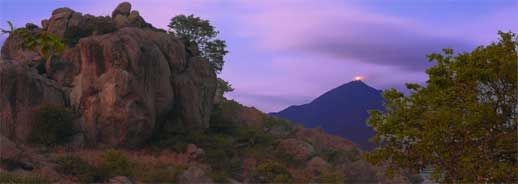
Arunachala Karthigai Deepa Jyoti
In the order of creation the next element to manifest is agni or fire. The huge temple of Arunachala at Thiruvannamalai is the agni sthala. The hill of Arunachala behind the temple is supposed to be the place where Lord Shiva manifested himself as a pillar of fire, the beginning and end of which neither Brahma nor Vishnu could discover. Every year a huge bonfire is lit on the hill which is visible for miles around to commemorate this event. I had been fortunate enough to visit this some years ago.
Jambukeshwar
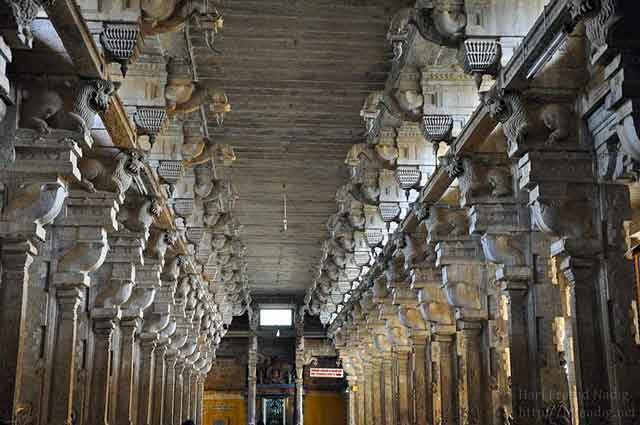
Jambukeshwar
Next in order of evolution comes apas or water. I had not been able to visit the apas-sthala so far and was not expecting to go. But as usual in this trip miracles seemed to happen and my friend said that in the evening after leaving Swamimalai we would go to Jambukeshwar. This is the apas-sthala and is in the town of Thiruvanaikkaval near Trichy. Until I reached there I did not realize that the temple to Jambukeshwar was in this city and we were actually going to it. We went at arati time. The small lingam is inside a small cave and normally one can have darshan through the latticed window facing it. But somehow we were allowed to go inside and the pujari invited us to wait for the arati. I am normally very claustrophobic and this was a small enclosed space with about ten people but I felt a sense of deep peace stealing over me. Then the priest took a light and showed us the spurt of water which was coming from the floor in front of the lingam. This is constantly coming out and the lingam itself is partially submerged in water which is ever flowing beneath.
This temple has a unique architectural design. It has five enclosures which rise to a height of thirty-five feet as well as many mantapams containing some rare sculptures. The lingam had originally been installed under an ancient Jambu tree, hence its name. Once it is said that Parvathi was banished to the earth by Lord Shiva for making fun of his yoga sadhana. She made a lingam out of water and installed it in this place. Shiva forgave her and allowed her to return to Kailasa. But she remains here under the name Akilandeswari.
Another legend about this temple says that two devotees of Shiva were once born as an elephant and spider due to some curse. The elephant worshipped the lingam by bringing water in his trunk and pouring it over the lingam. He also brought flowers and did puja. The spider worshipped the Lord by spinning a web on top to protect it from falling leaves. Very often the elephant’s worship would destroy the web and the spider was very angry and tried to go into the elephant’s trunk and stop him from bringing water and flowers. This of course drove the elephant mad and eventually both of them perished due to their unnecessary animosity.
EKAMRESWARA
The prithvisthala or the element of earth is found in the huge temple of Ekamreswara in Kanchipuram. This is another huge temple and I had been to it many times whenever I visited my guru in Kanchipuram. The lingam itself is supposed to be made of earth and not stone and it rests on a bed of earth which can actually be scraped off.
So the visit to Jambukeshwar completed my tour of the pancha
bhutasthalas of Lord Shiva.
Brihadeeswarar Temple at Thanjavur
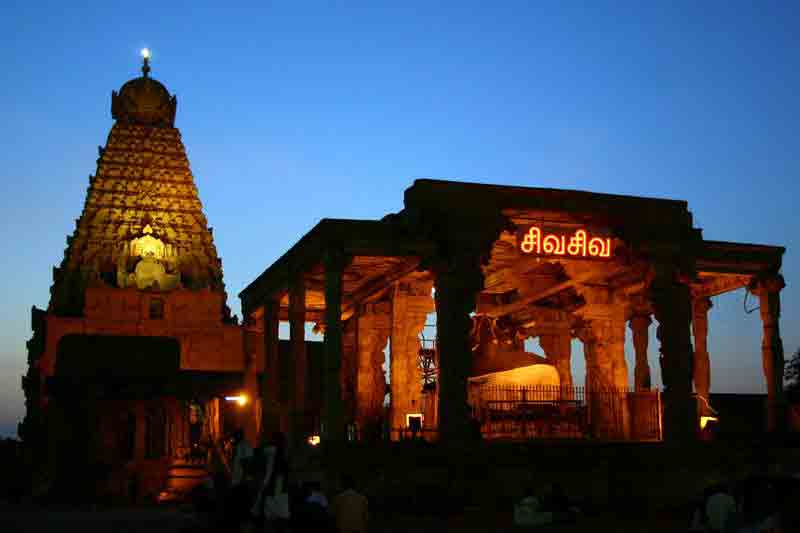
Brihadeeswarar Temple at Thanjavur was previously known as Rajarajeswaram. A long inscription on the walls of the Vimanam records the contributions of Raja Raja Chola and his sister Kundavai to the Thanjavur temple. The Cholas were one of the greatest and most gifted of the dynasties which ruled in S. India. The age of the Cholas (848-1279 AD) was the most creative period in the history of S.India. For the first time the whole of S.India was brought under a single government and the problems of public administration were looked into in a most systematic manner. Tamilnadu reached heights of excellence in the realm of art, religion and literature, during this period which was never again repeated. Rajaraja Chola was the greatest of the Chola kings. He created a century of glory for the Cholas. During the time of his son Rajendra 1 the empire spread and carried its culture beyond the seas. The wonderful temples of Angkor Wat in Cambodia carried the unmistakable stamp of Chola architecture. In fact one of the Khemer kings of Cambodia was supposed to have come to his court and invited him to send his architects and artisans to his country. Rajendra has been eulogised as having all the marks of a great and noble person. He is the one who built the Brihadeeswara or Rajarajeswara temple which is the best specimen of the most splendid period of S. Indian history. It was purely a royal temple entirely under the custody of the king, designed and built by him. No one who has seen the temple can help but be struck by the devotion, administrative ability and the generosity of this genius. He made all the parts of his land come under the protection of the temple. All sections of the country, his family, the army, officers, villagers and merchants all came together in maintaining the temple so they all felt a sense of belonging to the deity.
The temple stands within a fort, whose walls were later additions built in the 16th century. It is the world’s first fully granite temple. The towering Vimanam (temple dome) is about 200 feet in height and is referred to as Dakshina Meru. The octagonal Shikharam (pinnacle on top of the dome) rests on a single block of granite weighing 81 tons. It is believed that this block was carried up a specially built ramp from a site 6 kilometers away. Huge Nandis dot the corners of the Shikharam, and the Kalasam (golden pot on top of the roof) is about 3.8 meters in height. Hundreds of stucco figures bejewel the Vimanam, although it is possible that some of these may have been added during the Maratha period. The Shivalingam is a huge one, set in a two storied sanctum, and the walls surrounding the sanctum are a storehouse of murals and sculpture. The long prakaram surrounds the great temple (500 feet/250 feet), and the walls surrounding the prakaram again go back to Raja Raja Chola's period. The walls have long pillared corridors, which abound in murals, Shiva Lingams and Nandis. The Periya Nayaki temple within the temple is a later addition from the Pandya period, and so is the Subramanyar Temple sung later by the Saint poet Arunagirinathar. Incidents from the lives of the Nayanmars, several of the 108 Bharata Natyam Dance postures, manifestations of Shiva (Aadalvallaan - Nataraja, Tripurantaka, Dakshinamurthi etc.) are depicted in sculptured panels or in exquisite Chola murals. Both the interior, and the exterior walls of the temple, are replete with images of the kind described above.
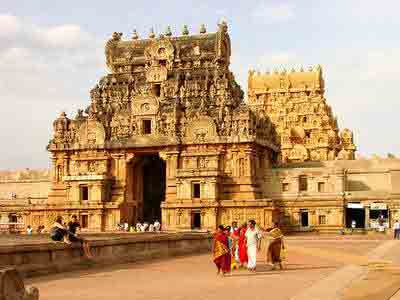
As usual we came to the town just before 1 pm and the temple was supposed to be open only till 12.30. I just ran inside without waiting for anyone and found that there was a queue going along the huge corridors leading to the sanctum. I was sure that by the time the queue wound its way to the front the doors would be closed so I did something which I seldom do. I crawled under the bars which separated incoming and outgoing people and ran to the front of the queue. I couldn’t help but gasp at the magnificent sight. The lingam was huge. I just gaped at it and cricked my neck in the process. But for me it didn’t have that aura of sanctity of the other temples we had visited. The size itself was intimidating. And of course compared to the other temples we had visited so far it was very young – only a thousand years old! The various approaches to it were also imposing. When you looked up and saw how tall even the corridors were, you couldn’t help but admire the architectural skill of the Cholas. For some vague reason which the priest was trying to explain to someone, the temple which should have closed at 12.30 was kept open till 1.10 pm. It was all part of the divine plan and no doubt we were meant to have darshan. We stayed there right in front for more than fifteen minutes before we were hustled off into the hot sunshine outside which seemed so garish after the quiet, secluded majesty of the temple corridors . I have a partiality for Nandi for without his permission one cannot go into any Shiva temple so I was looking around for the Nandi at the entrance. Of course in my mad rush to get into the temple I had quite missed him. It was only on the way back that I could admire him. He was a huge monolith weighing 25 tons and is 12 feet high and 20 feet long and was housed in his own mandapam. I thanked him for allowing me to have darshan despite the rules! Unfortunately we did not have time to admire all the wonderful sculptures and paintings that the temple was famous for. In a way this was not quite my idea of temple trotting. I always prefer to stay at one temple for at least three days and soak in the ambience of the place but somehow it seemed as if this was not to be in this trip. But since He arranges everything I had to bow to the divine will.
Srirangam-Renganathar
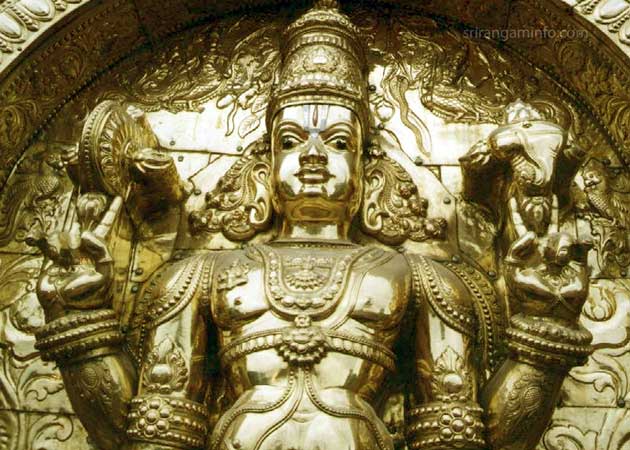
The pilgrimage to Sri Ranganatha at Srirangam near Trichy completed our five day pilgrimage of the temples of Tamil Nadu. I had been to this temple a very long time ago with my parents, when I was a child. The only memory of it was that of an awe-inspiring temple which left a sense of wonder in my mind and I was very anxious to visit it once again. It is one of the eight temples to Vishnu which appeared on its own accord and is known for being the greatest of the 108 divya desams or temples to Vishnu revered by Vaishnavites. Out of these 105 are in India, 1 in Nepal the other two are in the heavenly realms. The word “kovil” which is the Tamil word for temple, when uttered by a Vaishnavite refers only to this temple just as when the word “kovil” is said by a Shaivite, he means Chidambaram. The temple has been revered by all the three great Acharyas of the Vedantic schools, Shankaracharya of Advaita, Ramanucharya of the Visishtadvaita, and Madhva of the Dwaita. Ramanucharya stayed here for the best part of his life and there is a shrine devoted to him to which puja is done. All the Alwars have sung about this temple. The Alwars are the Vaishnavite saints corresponding to the Nayanmars of Shaivism. In fact this was the headquarters of the Vaishnavite revival movement.
The history of the temple goes back to aniquity. The origin of the glittering Sriranga Vimana (dome which houses the deity) is said to have been narrated by Rudra to Narada. According to the Sriranga Mahathmya the glittering Sriranga Vimana appeared in the depths of the Milky ocean as a result of Brahma’s intense tapas. It was transported from the Milky Ocean to Brahma’s abode by the celestial bird Garuda. Adisesha, the serpent bed of Vishnu, spread his hood over it. Vishvaksena, the chief of the guards walked in front clearing the way. The Sun and Moon walked on either side, fanning the Deity. The celestial musicians Narada and Thumburu followed singing His Glory. Rudra and other gods preceded with hymns. The celestial maids danced and the gods rained flowers in the path of the procession.
Brahma was awakened from his deep tapas, by the sounds of music. When he opened his eyes he saw this glorious spectacle, and prostrated before the Vimana. He recited the four Vedas and gazed in wonder at the magnificent sight. Sunanda, the celestial guard informed him that the Lord was pleased with his penance and had come in answer to his prayers. When Brahma looked into the Vimana, he found Vishnu resting with his consorts. The Lord informed Brahma that he had taken on this form of a reclining idol at his own volition. He said that such self born idols would appear in eight different places -- Srirangam, Srimushnam, Venkatadri, Saligrama (Nepal), Naimisaranya, Totadri, Pushkara and Badrinath. Ranga Vimana was the first and the earliest of all these. The Lord directed Brahma to worship him strictly according to the procedure for worship laid down in the Agamas. So saying He reverted to his characteristic posture, in Yoganidra called “Ananta shayana.”
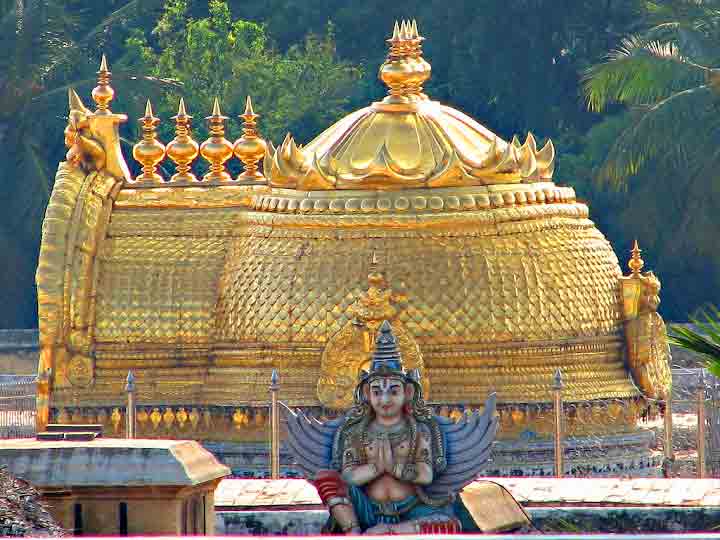
Sriranga Vimana
Brahma carried the Vimana to Satyaloka and installed it on the banks of the celestial river, Viraja. He appointed the Sun god to do the daily pooja. After him, Vaivasvata Manu, performed the worship. When his son Ikshvaku, became the King of Ayodhya, he was very anxious to have it installed at Ayodhya. Therefore he did severe tapas for hundreds of years. At last Brahma permitted him to take it to Ayodhya.
Thus, the Vimana came to Ayodhya. After Ikshvaku, his descendants continued the service. Rama, himself an avatara of Lord Vishnu, worshipped him and thereafter the Lord came to be known as "Periya Perumal". During the coronation which took place soon after his triumphant return from Sri Lanka, Rama gifted many things to many people. He gave the Vimana as a gift to Vibheeshana for the invaluable help he had rendered to him.
One of the kings of the Chola dynasty called Dharma Varma, had seen the Ranga Vimana at the Yagnashala of Dasaratha’s Putrakameshti Yaga in Ayodhya. He was so fascinated by it that he wanted to have it installed in his city. He undertook a terrific tapas on the banks of Chandrapushkarani. At last the sages told him that the Ranga Vimana would arrive soon at that very place and requested him to give up the penance.
It was at this time that Vibheeshana set out for Sri Lanka, with his precious burden. He got down on the Kaveri banks to perform his mid-day prayers. He placed the Ranga Vimana at the place known as "Sesha Peetam" near the Chandrapuskarani. He returned after taking his bath and performed the Pooja. But when he tried to lift the Vimana, it would not budge. It was rooted right there where he had left it. Vibheeshana was overcome with grief. The Lord appeared before him and consoled him by saying that He had decided to make this place His abode. He told Vibhishana that he could come and worship him daily. It is said that Vibheeshana comes from Sri Lanka every night and worships the Lord at midnight.
Dharma Varma was overjoyed that the Lord had decided stay in his city. He built a huge shrine for the Vimana. The enclosure surrounding the Vimana is still known as "Dharma Varma Veedhi". He arranged for all the prescribed methods of daily worship.
The Peria koil or big temple in which Sri Ranganatha stays in a reclining position on his serpent bed, lies on an islet, formed by the twin rivers Kaveri and Kollidam which is supposed to be the celestial Viraja. Rivers have always been a very important part of any temple and are held to be as sacred as the temple.
In course of time, Nature devoured the site. The Sri Ranga Vimana and all the structures disappeared and became a habitat for wild animals. After many years a ruling prince of the Chola dynasty came to that spot while hunting and overheard a parrot repeating a hymn pointing out the importance of this place.
On understanding the import of this sloka, the prince caused the earth towards the west of the tree (known as Tirumudikkurai) to be dug deep to lay a secure foundation for the Sriranga Vimana. But the Lord appeared before him in a dream and pointed out to him the exact spot wherein he lay. The king was overjoyed at finding the glittering Ranga Vimana. He cleared the forest, constructed all the essential parts of the temple, laid down flower gardens, instituted temple services and forms of worship. The shrine became widely knows as "Tiruvaranga Tirupathi".
The present temple is a huge structure sprawling over a huge area of 156 acres. It has seven prakaras or enclosures. There are 21 towers in all the prakaras. This is the only temple in India with seven prakaras. Seven is a symbolic number which stands for the seven chakras in the human body as well as the seven elements which make the human body inside which dwells the Paramatma. The Rajagopuram which is the main tower is the tallest temple tower in the world. It was built in 1983 and is 236 ft. tall.

The Orlov diamond 189.62 carats (37.924 g)
There are many stories concerning this temple. The Orlov diamond 189.62 carats (37.924 g), is a large diamond that is now part of the collection of the Diamond Fund of the Moscow Kremlin. This huge diamond which is as big as half an egg once formed one of the eyes of Sri Ranganatha. Legend has it that a French soldier who had deserted during the Carnatic wars in Srirangam disguised himself as a Hindu convert and stole it in the year 1747.
Of course I learnt about the history of the temple later but thought it best to educate the readers about the temple before going into my personal account. I hardly thought we would make it here since we had such a tight schedule but a number of unprecedented events forced us to cancel Kanchipuram and thus allowed us to stay one night at Trichy. We reached at about 4 pm and went immediately to the temple. One has to pay a small fee to enter by the special entrance. Following the queue, we came up to the sanctum. It took some time for the eyes to adjust to the dim light of the sanctorum. But once I got used to it I gasped in wonder at the fascinating form of Vishnu in His famous Ananta Shayana pose, reclining on the divine serpent, Ananta with eyes closed in yoganidra. This was Andal’s Lord. She was one of the most famous of the Alwars. It is said that when she completed her immortal song called the Thiruppavai she merged into the idol. Apparently she used to come by boat along the river from her own abode at Sri Perumbadur. There is a shrine dedicated to her in this temple. I could see her in my mind’s eye sitting before the Lord and reciting her immortal poem and the Lord receiving her into His arms. Unfortunately we were told to push on and not stand for a long time before the Lord. However while doing the outer prakara, we could get a wonderful view of the actual ‘Vimana” which is an elongated dome-like structure made of gold. It shone with a divine light. This was not created by human beings but self made as Lord Vishnu had told Brahma.
I’m always anxious to come for the morning puja at any temple and we found out that the opening ceremony when the Lord is woken up was at 6.15 am. Of course we could foresee a huge crowd so decided to come by 5 am. We were told that only fifty tickets would be issued which would allow us to enter the mandapam facing the deity and only these fifty fortunate ones could witness this unique puja. We reached by 5 am and somehow found ourselves in the queue for the morning tickets. This itself was a miracle since there was utter confusion with people running here and there not knowing which queue to stand in. We got inside and sat facing the door of the sanctum. Very soon a most auspicious looking cow and a white horse were brought inside and placed in front of us. Apparently sometimes an elephant is also brought. The conchs blew and the Vedas were chanted to rouse the Lord. The doors opened to these auspicious sounds and the lowing of the cow and neighing of the horse. This was a unique sight and we felt blessed to have witnessed this. After about fifteen minutes, the animals were led outside and we were allowed to go inside. The darshan of the Lord was the same as on the previous day. You never felt satisfied since the guards were always compelling us to keep walking and my heart was yearning to stay for a few minutes in front of His enchanting form. However we felt blessed to have been able to have had such a wonderful darshan. When we came out we were able to stand at the spot from where we could get a splendid view of the golden Vimana. It was glittering in the early morning light with an unearthly radiance. I closed my eyes and meditated on His divine form inside. At the entrance of the temple, in the first prakara, there was a colossal figure of Garuda, the eagle vehicle of the Lord. Of course there were many more magnificent things to be seen in the temple but since we were pressed for time we contented ourselves by going to the Sri Ramanuja temple and Sri Andal’s temple. Ranganayaki is Lord Ranganatha’s consort. This is another name for Lakshmi Devi. Her temple is in the outer prakara.
At last we tore ourselves away from the divine presence and set off on our journey to Chennai which we had to reach before it got dark.
Mariamman at Samayapuram
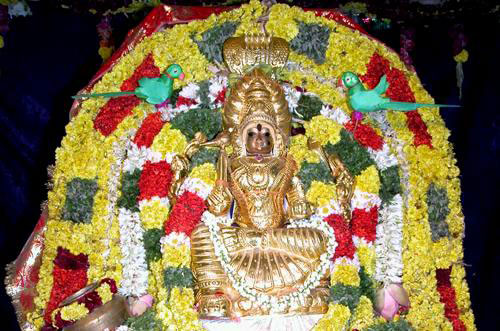
Mariamman temple at Samayapuram
However we had one more treat in store for us.
Since we had not been able to visit the Kanchi Kamakshi temple, it seemed as if the goddess decided to give us a special treat on our way back. Twenty kms from Trichy, the driver asked us if we would like to visit a famous Mariamman temple at Samayapuram. Of course we agreed with alacrity. Mariamman is a form of Shakti worshipped in Tamilnadu. She has a lot of healing powers and was always invoked during epidemics of small pox in olden times and chicken pox in modern times. We entered through a wide covered corridor and went straight up to the idol. Her face was totally covered in vermilion and she wore a charming green skirt and blouse. I fell in love with her at first sight. Her sparkling eyes seemed to be sending some sort of message to me.
I was told that she was a very powerful deity and certain to listen and fulfil all the requests of her devotees. I could well believe this after having seen her beauteous smile. Many pujas are done and lights are placed in different places to appease her when she is in a terrific mood. But at the moment I could only see her most benign and compassionate expression. I was drawn to buy a photo of hers which now resides on my altar. This was strange since I did not have the habit of buying photos from all temples and crowding my altar. But now she sits there and smiles at me during puja and arati. This was definitely the last of our temple visits and we had to put a special effort to reach Chennai before sundown.
| Hari Aum Tat Sat | |||||||||
|
